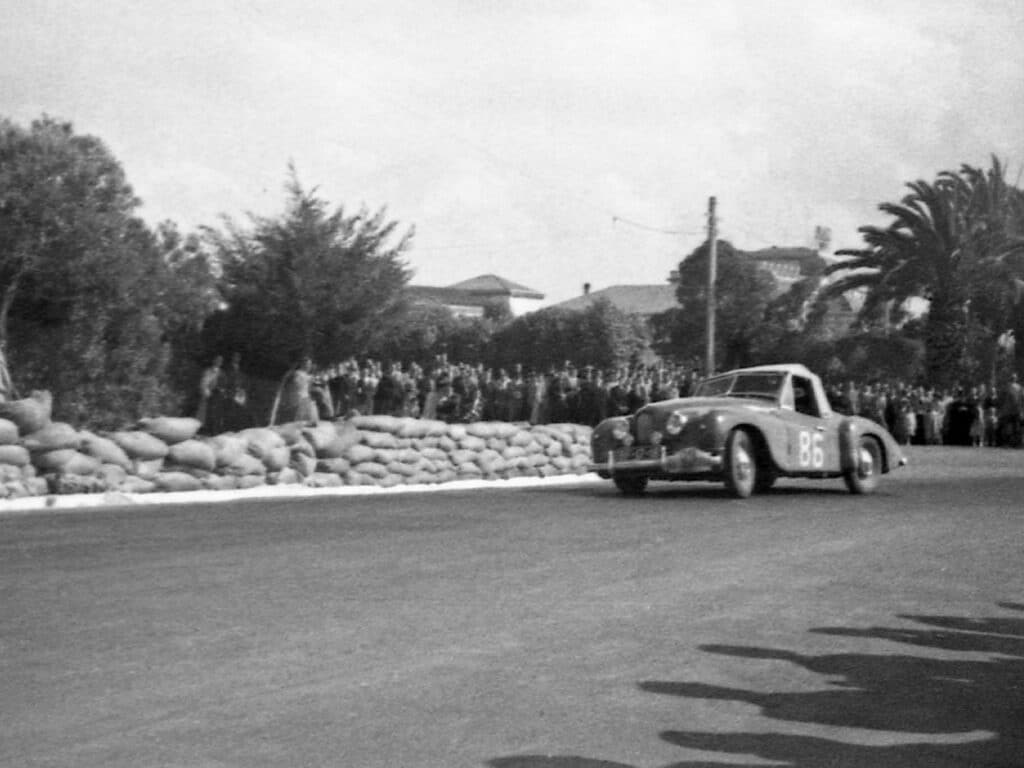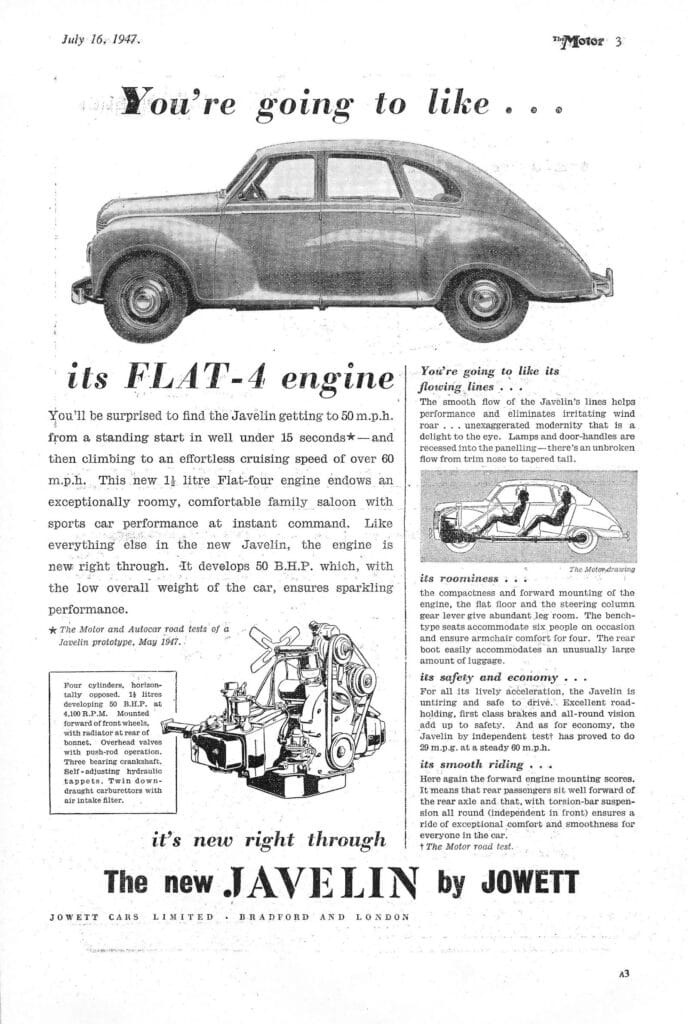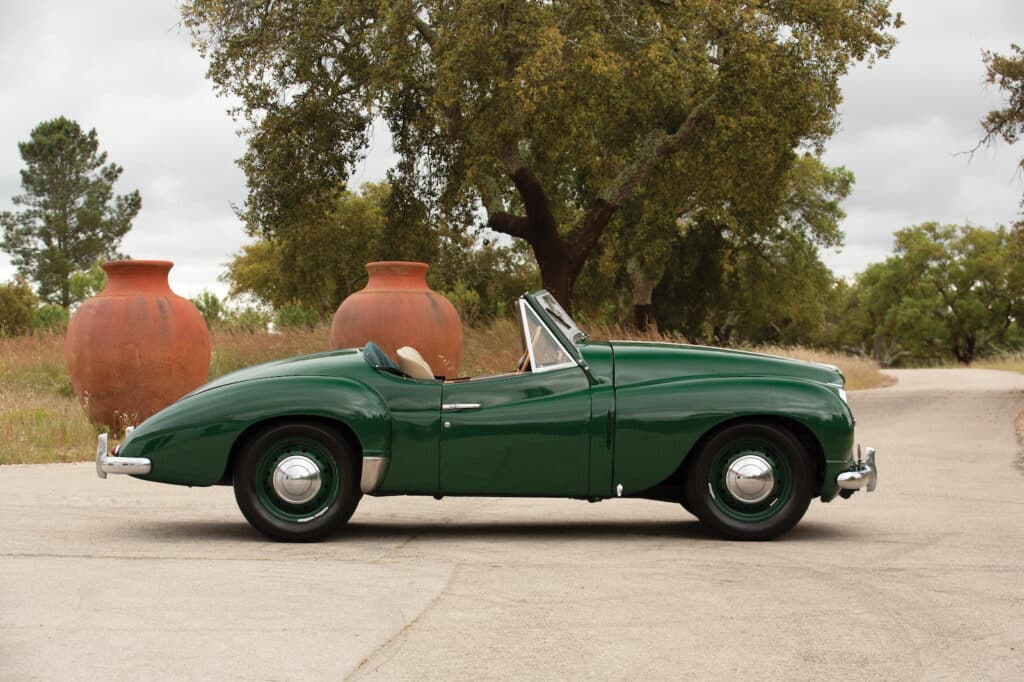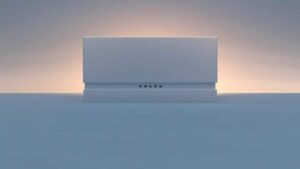
It was the unlikeliest of cars from the unlikeliest of automaker. It was the Jowett Jupiter, the only sports car built by Jowett Cars, Ltd. — a longtime British manufacturer of 2-cylinder automobiles.
Introduced this week at the London Motor Show in 1949, it would go on to score class wins at the 24 Hours of Le Mans and Monte Carlo International Rally.
But it did little to save the company from extinction.
A modest start

Our story starts when brothers Benjamin and William Jowett began manufacturing V-twin engines at the turn of the previous century.
They went on to establish the Jowett Motor Manufacturing Co. in 1901 in Yorkshire, England, initially building bikes until they created their first prototype car in 1906. It would enter production in 1910. The company reorganized after World War I, becoming Jowett Cars Limited, building 3,500 vehicles in a good year.
To generate money, the Jowetts attempted to go public in 1935, but their proposal was rejected. As a result, Charles Calcott Reilly took control after the brothers retired. Reilly added two more cylinders to the Jowett side-valve flat 2-cylinder engine, while nabbing contracts to produce flat-twin-powered generators during World War II.
But Reilly began contemplating the postwar market. He surmised that British market demand would be minimal, meaning the company would have to export cars to continue operating. For that, he would a car designer.
Reilly found him in Gerald Palmer, then running MG’s design studio. Palmer joined Jowett in January 1942, where he would enjoy an extensive amount of freedom in creating cars, with his first assignment being the creation of a six-passenger sedan.

A new car’s birth
It arrived in 1946. Dubbed the Jowett Javelin, the appearance of the new sedan revealed Reilly’s fondness for the Lincoln Zephyr. The car’s cabin proved particularly spacious due to its aluminum 1.5-liter overhead-valve horizontally opposed 4-cylinder engine, rated at 50 horsepower.
Three years later saw Palmer returning to MG, even as Aston Martin’s Roy Lunn joins the firm as an engineer. Lunn had worked on the Aston Martin DB2, and would go on to become the chief engineer for the Ford GT40.
He would be joined at Jowett by former Auto Union engineer Eberan von Eberhorst, whose credentials include the 1938-’39 Auto Union Silver Arrow 3.0-liter Grand Prix cars.

At Jowett, Lunn set about redesigning the Javelin’s front suspension with the thought of producing a two-seat roadster in an effort to duplicate the MG TC’s success in America.
So, the company used the Javelin’s engine, transmission and suspension in a new tube-frame chassis and cloaked it new sheetmetal. For the new two-seat roadster, the engine was placed ahead of the front axle, with the radiator mounted behind it. It also got an extra shot of juice, now rated at 60 horsepower.
The resulting car, the Jowett Jupiter, debuting at the London Motor Show this week in 1949 sporting rack-and-pinion steering, mechanical brakes and curvaceous clothing. Weighing 1,500 pounds, the Jupiter could run 0-60 mph in 15 seconds.

Certainly, the car came as a surprise; the company had never built a sports car. But the little roadster proved very competitive, attaining back-to-back class wins at the 1950 and ’51 24 Hours of Le Mans, as well as first and second in class and sixth overall at the 1951 Monte Carlo International Rally.
What happened next
While theJowett Jupiter could attain speeds of more than 90 mph on the track, on the street, they proved more problematic.

Tom McCahill, the influential automotive journalist for Mechanix Illustrated, wrote at the time that the Jupiter “dives into corners like a porpoise with heartburn and the steering is like winding an eight-day clock with a broken mainspring.”
Bad reviews aside, the Jupiter tended to overheat, the transmission proved unreliable and the front suspension was inclined to break. Chronically unreliable, both the prettier, more reliable and similarly priced, Jaguar XK120 and cheaper Austin-Healey doomed the Jowett Jupiter’s chances.
As if that wasn’t bad enough, sales of the Javelin sedan started falling off, and the Jupiter did little to compensate. But then, things got worse.
In 1953, the British government lops 25% off the purchase tax on new cars, leading to a surge in demand. The uptick leads Ford Motor Co. to buy Briggs, which supplied bodies for Jowett. Facing a shortage of bodies, production stops in July 1954, after 825 Jupiters had been built.
The Jowett factory is sold to International Harvester, which uses it to produce farm tractors. By 1955, Jowett is history.
- SEO Powered Content & PR Distribution. Get Amplified Today.
- PlatoData.Network Vertical Generative Ai. Empower Yourself. Access Here.
- PlatoAiStream. Web3 Intelligence. Knowledge Amplified. Access Here.
- PlatoESG. Carbon, CleanTech, Energy, Environment, Solar, Waste Management. Access Here.
- PlatoHealth. Biotech and Clinical Trials Intelligence. Access Here.
- Source: https://www.thedetroitbureau.com/2023/09/the-rearview-mirror-a-sports-car-from-a-company-youve-never-heard-of/
- :is
- :where
- 1
- 15%
- 1949
- 1951
- 24
- 50
- 500
- 60
- 90
- a
- About
- Ad
- added
- After
- ahead
- also
- america
- amount
- an
- and
- arrived
- AS
- aside
- At
- attain
- attempted
- auto
- automobiles
- automotive
- Bad
- BE
- become
- becoming
- been
- began
- behind
- being
- Benjamin
- bodies
- both
- Break
- British
- Broken
- brothers
- Building
- built
- Bureau
- but
- buy
- by
- came
- car
- cars
- Century
- chances
- Charles
- chassis
- cheaper
- chief
- class
- Clock
- Clothing
- CO
- company
- competition
- competitive
- continue
- contracts
- control
- corners
- could
- created
- Creating
- creation
- Credentials
- credit
- debuting
- Demand
- Design
- Designer
- DID
- Doomed
- dubbed
- due
- during
- effort
- Engine
- engineer
- Engines
- England
- enjoy
- enough
- Enter
- establish
- Even
- export
- extensive
- extinction
- extra
- facing
- factory
- Falling
- farm
- Firm
- First
- flat
- For
- Ford
- Former
- found
- Freedom
- from
- front
- generate
- generators
- Go
- good
- got
- Government
- grand
- had
- happened
- Have
- he
- heard
- him
- his
- history
- HOURS
- HTTPS
- i
- if
- ii
- in
- Inclined
- include
- Influential
- initially
- International
- into
- IT
- ITS
- jaguar
- January
- joined
- Joins
- journalist
- jpg
- July
- Jupiter
- later
- leading
- Leads
- like
- Limited
- Lincoln
- Lisbon
- little
- London
- Ltd
- Manufacturer
- manufacturing
- Market
- Martin
- max-width
- meaning
- mechanical
- minimal
- mirror
- modest
- money
- more
- Motor
- never
- New
- now
- of
- off
- on
- only
- operating
- opposed
- overall
- Palmer
- particularly
- photo
- placed
- plato
- Plato Data Intelligence
- PlatoData
- pounds
- previous
- produce
- producing
- Production
- proposal
- prototype
- proved
- public
- purchase
- rally
- rated
- redesigning
- Rejected..
- reliable
- result
- resulting
- returning
- Revealed
- Reviews
- roy
- Run
- running
- sales
- Save
- saw
- score
- Second
- seconds
- set
- shortage
- shot
- show
- Silver
- Similarly
- sixth
- sold
- speeds
- Sports
- started
- starts
- steering
- Stops
- Story
- street
- studio
- success
- supplied
- surge
- surprise
- suspension
- tax
- than
- that
- The
- their
- then
- they
- things
- this
- this week
- thought
- time
- to
- took
- track
- TURN
- two
- union
- until
- used
- uses
- Ve
- Vehicles
- very
- von
- war
- was
- week
- weighing
- WELL
- went
- when
- which
- while
- whose
- william
- Wins
- with
- worked
- world
- worse
- would
- wrote
- year
- years
- you
- zephyr
- zephyrnet











